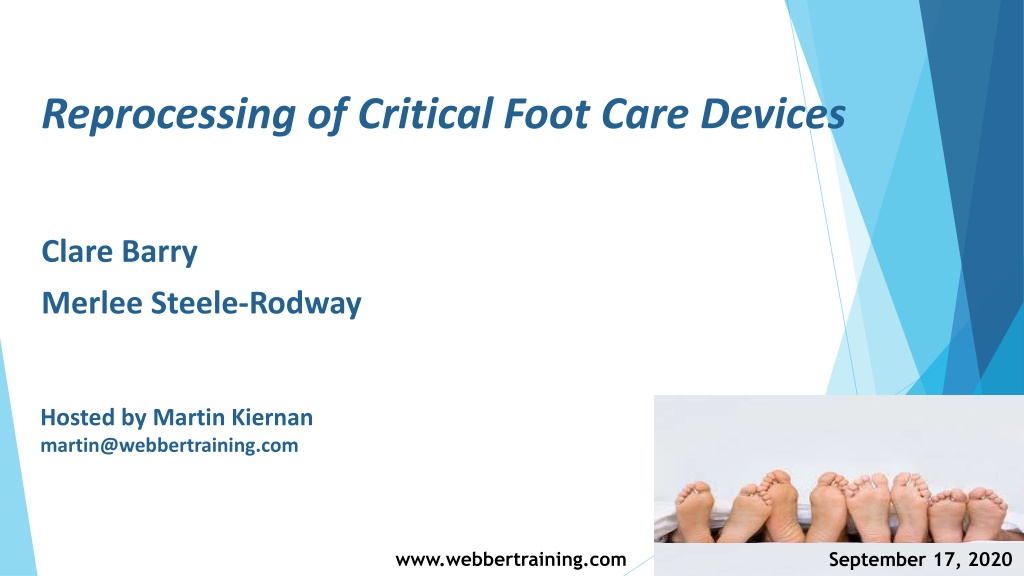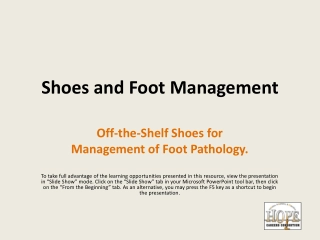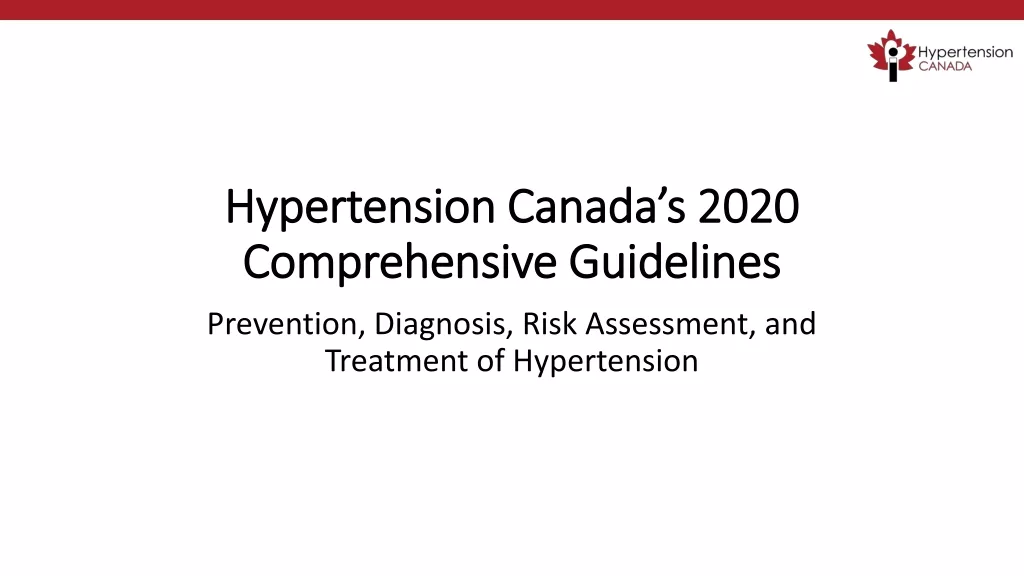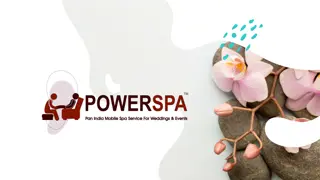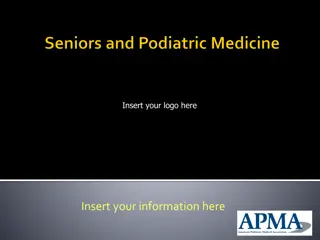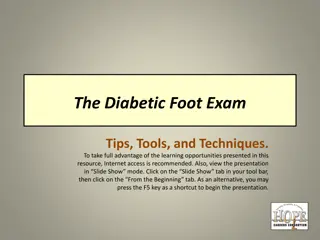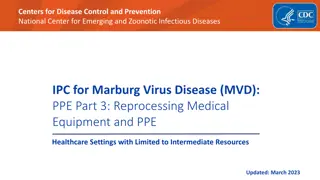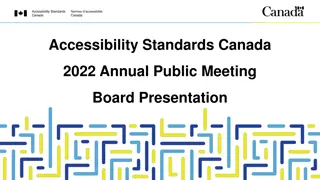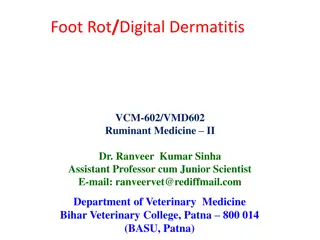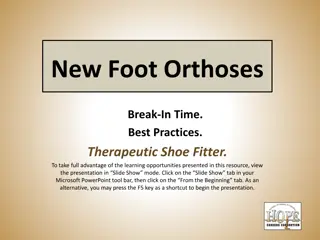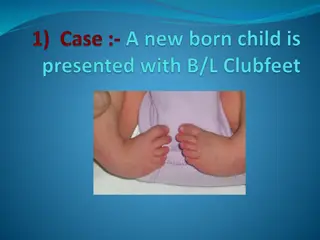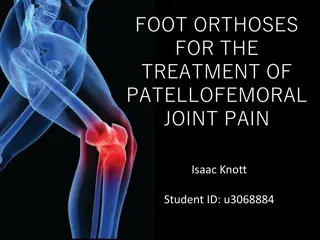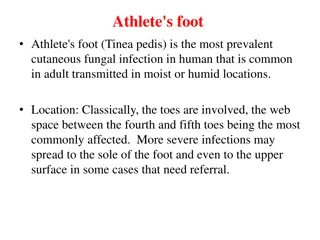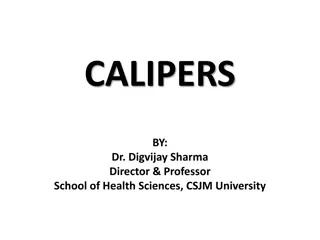Reprocessing of Critical Foot Care Devices: IPAC-Canada Guidelines
This presentation discusses the Infection Prevention and Control guidelines for the reprocessing of critical foot care devices in healthcare settings. It highlights the importance of proper cleaning, disinfection, sterilization, and storage of equipment to prevent healthcare-associated infections. The document aims to provide clear recommendations for healthcare providers involved in foot care to ensure safe practices and reduce the risk of outbreaks.
Download Presentation

Please find below an Image/Link to download the presentation.
The content on the website is provided AS IS for your information and personal use only. It may not be sold, licensed, or shared on other websites without obtaining consent from the author. Download presentation by click this link. If you encounter any issues during the download, it is possible that the publisher has removed the file from their server.
E N D
Presentation Transcript
Reprocessing of Critical Foot Care Devices Clare Barry Merlee Steele-Rodway Hosted by Martin Kiernan martin@webbertraining.com www.webbertraining.com September 17, 2020
This presentation reflects Infection Prevention and Control- Canada s (IPAC-Canada) Reprocessing of Critical Foot Care Devices Position Statement (July 2019) Practice Recommendations for Foot Care in Healthcare Settings (November 2019) AND Canadian Standards Association (CSA) Z314-18 Canadian Medical Reprocessing 2
Disclosures Some images in this presentation were obtained from Google Images 3
IPAC-Canada Position statement is written for health care providers who perform foot care or reprocess critical foot care devices. It is not intended for addressing foot care practices performed by the client or the clients family. 4
Foot care equipment/devices have been linked with healthcare associated infections (HAI) and outbreaks across the health care continuum. 5
Purpose of IPAC Canada Position Statements To provide IPAC recommendations for the management of critical foot care equipment and/or devices This includes cleaning, disinfection, sterilization, and storage The goal of document was to develop a user-friendly document with clear direction for safe reprocessing of critical devices used for foot care A reference list of guidelines and resources is provided 6
Process for Developing Position Statement IPAC-Canada conducted an extensive review of: the existing national and global practices. outbreaks associated with foot care and the current evidence. Draft statements circulated to experts and stakeholders, including Canadian Foot Care Association (CAFCN), Canadian Association of Medical Device Reprocessing (CAMDR),IPAC- Canada s Community Healthcare Interest Group (CHIG) and Reprocessing Interest Group (RIG). Following this, it was reviewed by IPAC Canada Standards and Guidelines and endorsed by the IPAC-Canada Board of Directors. 7
Objectives Provide overview of health care associated infections and outbreaks associated with performing foot care. Review the rationale for IPAC Canada s position statement on Reprocessing of Critical Foot Care Devices. Discuss the three options for providing safe critical equipment for each client Identify key references 8
Hepatitis B (HBV) and Hepatitis C (HCV) Outbreaks associated with foot care reported to CDC Reference: Centers for Disease Control and Prevention. Healthcare-Associated Hepatitis B and C Outbreaks Reported to Centres for Disease Control and Prevention (CDC) 2008-2017; 2018; August 21. https://www.cdc.gov/hepatitis/outbreaks/healthcarehepoutbreaktable.htm Nursing home: 7 infected 7 infected of which sequencing of DNA from 4 acute infections matched into a cluster with one chronic case. Sequencing could not be performed for 3 cases. Infection control breaches related to instrument sterilization during the provision of podiatry care were identified; however, evidence was insufficient to implicate a specific source of transmission. 9
CDC Hepatitis B and C outbreaks(contd) Assisted living facility: 2 infected Failure to maintain separation of clean and contaminated podiatry equipment. Improper reprocessing of contaminated podiatry equipment Failure to perform environmental cleaning and disinfection between patients Nursing home: 46 infected Epidemiological analysis suggested podiatry care, phlebotomy, nail care performed at skilled nursing facility were associated with HCV 10
Examples of Outbreaks(contd.) Wise ME, Bancroft E, Clement EJ, Hathaway S, High P, et al. Infection Prevention and Control in the Podiatric Medical Setting: Challenges to Providing Consistently Safe Care. 2015 J AM PodiatrMedAssoc105(3):264-272. http://www.ndhealth.gov/disease/hai/docs/wise%20infection%20prevention%20and %20control%20in%20the%20podiatric%20setting%20japma%20201....pdf Nursing facility: 9 acute hepatitis B (HBV) infections identified of which 5 received care from a visiting podiatric physician on the same day. Observations revealed instruments (nail clipper, cuticle, and tissue nippers) were visibly contaminated with blood after use. 3 had the same viral sequence. Epidemiologic evidence and molecular evidence pointed to breakdowns in basic infection prevention and control procedures. Single assisted living facility: 2 HBV cases 11
Examples of Outbreaks(contd.) 6 Proteus mirabilis wound infections related to contaminated bone drills used in outpatient podiatry surgery Multi reports from unsafe practice of injections: 13 Methicillin-resistant Staphylococcus aureus (MRSA) soft tissue infections after injections in a podiatry medical clinic 10 cases of Mycobacteriumabscessus soft tissue infections related to a jet injector used to administer lidocaine Others 12
Examples of Outbreaks (contd.) Wise ME, Marquez P, Sharapov U, Hathaway S, Katz K, et al. Outbreak of acute hepatitis B virus infections associated with podiatric care at a long-term care facility. Am J Infect Control. 2012 Feb;40(1):8-21. https://www.ncbi.nlm.nih.gov/pubmed/21835502. [Accessed 28 August, 2018]. HBV outbreak in psychiatric long-term care residents: 5 of 15 residents (33%) undergoing podiatric care on a single day developed acute Hepatitis B infection. Infection control observations of consulting podiatrist revealed opportunities for cross- contamination of instruments with blood exposure to HBV during podiatry was likely the dominant mode in this outbreak. Long-term care facilities should ensure compliance with infection control standards among staff and consulting health care providers. 13
Client Safety Clients expect and require safe care regardless of where the procedure is performed. Clients and providers can be put at risk of acquiring infections Viral Blood borne pathogens Hepatitis B & C Human Immunodeficiency Virus (HIV) Bacteria and Fungi How can infections be spread? penetrating skin accidently sharp instrumentation contaminated with blood/body fluids during care and used on clients without correct sterilization organisms moved from client to client through contaminated devices weeping areas or non intact skin; e.g., hands of provider 14
Stakeholders and Health care providers Stakeholder: Healthcare provider performing foot care in any health care setting, which includes, but is not limited to care provided in private homes, clinics and healthcare settings. Healthcare provider: Any healthcare professional delivering foot care service to a client as well as those performing reprocessing duties. 15
Health care settings include Healthcare setting: Any location where healthcare is provided, including home healthcare, offices of other health professionals, outpatient clinics, emergency care, hospitals, complex continuing care, rehabilitation hospitals, long-term care homes, mental health facilities, community health centres and clinics, physician offices, dental offices, independent health facilities, out-of- hospital premises and public health clinics. 16
Why Equipment is to be Sterile? Each client interaction requires a sterile set of foot care equipment/devices. Why? In the delivery of foot-care services, equipment/devices may intentionally or unintentionally come into contact with blood, body fluids, or non-intact skin, requiring sterilization. Therefore it is imperative to manage all equipment as if it has been contaminated. Soil is not always readily visible. Infection prevention and control best practices indicate there should be one reprocessing system for all equipment from any client. 17
Position statement indicates: 1. Reusable foot care equipment/devices are considered critical devices.* Therefore each client interaction requires a sterile set of foot care equipment/devices. *Critical: medical equipment that enters sterile tissues, including the vascular system (e.g. biopsy forceps, foot care equipment, etc.) Critical medical equipment present a high risk of infection if the equipment is contaminated with any organism. Reprocessing critical equipment involves meticulous cleaning followed by sterilization. 18
Examples of Critical devices Scalpel handle Nail elevator Scissors Debris evacuator Callus parer Single ended Blacks file Halsted mosquito forceps Double ended Blacks file Probe Barrel nail nipper Nail Splitter Diamond Deb file Curette Stainless steel foot paddle handle 19
Single Use Devices/Equipment Scalpel blades Callus Parer blade Foot paddle sanding pad Monofilament Nail Clipper Nail files/emery board/orange stick Toe and/or Ingrown Nail Nipper - unless the Manufacturer provides instructions for steam sterilization 20
Position statement indicates: 2. All healthcare providers: shall have sufficient numbers of foot care equipment/devices/kits to ensure sterile equipment, either single use or properly reprocessed, for each individual client treatment. are responsible to ensure that the client is not placed at risk of infection when reusing any foot care equipment/devices during the provision of care. 21
Position statement indicates: 3. Reprocessing of reusable foot care equipment/devices shall (CSA definition)meet manufacturers instructions for use (MIFU), current national guidelines such as Canadian Standards Association (CSA), the Public Health Agency of Canada (PHAC/Health Canada), and provincial standards. 4. Reusable equipment/devices are sold with manufacturer instructions for use (MIFU), including for proper cleaning and sterilization, and shall not be purchased, used, or reprocessed without these. 5. Determine reprocessing methods in advance of purchase. 22
Position statement indicates: 6. Single-use medical equipment/devices do not have MIFU s and shall not be reprocessed. 7. If the process used for reprocessing cannot meet the current standards identified previously, single use disposable items shall be used and discarded after use. Nail clippers should be deemed single use if no MIFU is available or if the MIFU do not meet recognized standards. 23
Position statement indicates: Medical equipment/devices used to provide foot care should be approved or licensed for medical use and designed for use on humans, specifically feet (e.g., rotary sanding devices and accessories including burs). Burs/disks and rotary sanding tools - if used, should be purchased from an authorized medical manufacturer. The burs/disks must be a single use device and not reprocessed unless the manufacturer provides a MIFU that meets the CSA and Public Health Agency of Canada (PHAC) Guidelines. Podiatry drills intended for therapeutic purposes (e.g. treatment of calluses and nails, hyperkerathosis, fungal infected nails) are generally considered to be Class II medical devices in Canada. Class II medical devices need a medical device licence in order to be imported, sold, or advertised in Canada (Communication from Health Canada-Oct.9,2019) 24
Three Options to achieve a sterile set of foot care equipment/devices for each client interaction All options must meet the previously identified standards. Option 1: Use single-use sterile disposable equipment/devices and discard appropriately after use 25
Option 2 Multi-client reusable foot care equipment/devices reprocessed using the contracted services of a centralized Medical Device Reprocessing Department (MDRD). The contracted MDRD meets the CSA standards and has qualified technicians to perform the reprocessing (cleaning and steam sterilization). 26
Option 2(contd.) This equipment requires thorough decontamination (cleaning and disinfection), packaging, and steam sterilization between each client use, and shall follow CSA standards for storage of sterile supplies to ensure they maintain sterility. Best practices for transportation and storage of soiled and reprocessed equipment/devices shall be incorporated and meet current CSA standards. There shall be a robust process for recall of reprocessed equipment/devices in the event of reprocessing failure. Load records, proper labelling, and chemical and biological indicators are required. 27
Option 3 The healthcare provider chooses to reprocess reusable equipment/devices themselves, with the following considerations incorporated into practice: purchase current pertinent CSA standards documents for reprocessing practices and purchasing and follow these along with provincial reprocessing guidelines. healthcare provider shall have written procedures based on current standards. 28
Option 3(contd.) Education: Personnel involved in all medical device reprocessing functions shall be prepared for the tasks that they are required to perform through formal education and training . . . 3 including at a minimum: following national and provincial guidelines. ensure education and competency related to all equipment/devices used in the process; maintenance, quality testing, monitoring of the sterilization process; packaging, storage and transportation of reprocessed equipment/devices including chemicals and sterilization equipment. training to a level required for the volume and complexity of the equipment. 29
Option 3(contd.) Reprocess equipment following the MIFU for the device and the sterilizer. Ensure the MIFU for each piece of equipment meet recognized accepted standards for reprocessing. Steam sterilization is required for critical foot care instruments and the sterilizer requires a printout or electronic record for each cycle. Follow quality assurance recommendations, including monitoring and documentation of mechanical, chemical, and biological indicators. 30
Option 3(contd.) There shall be a robust process for recall of reprocessed equipment/devices in the event of reprocessing failure, including labeling of all packages with the sterilization date, load, sterilizer number, name of the medical device, and initials of the person who performed the packaging. Best practices for transportation and storage of soiled and reprocessed equipment/devices shall be incorporated. If using event-related sterility, a quality system is required with policies and procedures for the storage process. 31
Option 3(contd.) Incorporate a preventative maintenance schedule according to equipment MIFU, including maintenance procedures, cleaning frequency of steam sterilizer and reprocessing area as well as annual steam sterilizer calibration by a certified technician. There shall be a procedure outlining actions to be taken if parameters of cleaning and sterilization are not met, including documentation of steps taken to remediate. 32
Option 3(contd.) The foot care provider shall follow Occupational Health & Safety and IPAC guidelines (e.g., Routine Practices and Additional Precautions, appropriate personal protective equipment for the task, safe sharps management, hand hygiene, and the procedure for staff exposures that occur during reprocessing). 33
Unacceptable methods of sterilization for critical foot care equipment Note: The use of liquid chemicals for sterilization of instruments is not recommended for critical equipment/devices that are used for sterile procedures due to the limitations in maintaining sterility to point of use. Devices cannot be wrapped or adequately contained during processing in a liquid chemical sterilant to maintain sterility following processing and during storage. * *Reference: Centres for Disease Control (CDC). Guideline for Disinfection and Sterilization in Healthcare Facilities, 2008.Last updated Feb 15,2017 [cited 2018 Feb 6] Accessed at: https://www.cdc.gov/infectioncontrol/pdf/guidelines/disinfection-guidelines.pdf. Rutala WA, Weber, DJ. Disinfection, sterilization and antisepsis: An overview. AJIC 2019:47(supplement): A3-A9 34
Unacceptable methods of sterilization for critical foot care equipment Unacceptable methods of sterilization include Immediate-Use Steam Sterilization (IUSS),formerly referred to as Flash sterilization, glass bead sterilizer, microwave oven, boiling, chemiclave, steam sterilizers without printouts or electronic recording and ultraviolet irradiation Note: IPAC Canada practice statement adds: Multi-functional domestic appliances are also unacceptable for sterilization such as dishwashers, pressure cookers, and toaster ovens. If an existing steam sterilizer does not have a printer or electronic recording device (USB), CSA recommends that there is a plan to update or replace the sterilizer to bring this into compliance. 35
Checkpoint 1. What is happening in your long-term care facility or Outpatient clinic or your foot care practice performed by health care providers? 2. Does the equipment/device used meet the CSA Z314.18 standard and the IPAC Canada Position statement on reprocessing of critical foot care equipment? (Note: This standard is for reprocessing in all health care settings- see #1.2) All Health care providers, contracted or independent and the organization employing them are accountable to verify the equipment is reprocessed according to CSA standards. Verify foot care providers are following current recommendations on management of critical care devices between clients and following Routine Practices as well as Occupational Health and Safety Guidelines. Periodic auditing of reprocessing practices is recommended 36
Checkpoint Does your organization have a policy on client owned equipment used by the client or family? There shall be written policies and procedures for the provision of a foot care program. Assessment of a clients foot care needs should be part of the individuals care plan. The clients basic foot care includes assessment, identification of infection, injury or other problems. Consult Infection Prevention & Control and Quality & Risk to identify the organizations risk and develop a policy. 37
IPAC-Canada Position statement is written for health care providers who perform foot care or reprocess critical foot care devices. It is not intended for addressing foot care practices performed by the client or the clients family. 38
Accountability when choosing Options Any of the 3 options used in Canada; must meet CSA Standards AND take into account: costing & liability analysis verify correct workflow and workspaces utilize equipment that meets standards as well as preventative maintenance storage and transportation ensure ongoing quality assurance, auditing, training and competencies 39
Are we required to use a steam sterilizer to sterilize critical reusable foot care devices? Answer: YES Multi client reusable foot care devices classified as critical items are to be cleaned thoroughly and steam sterilized in the correct cycle as per CSA and the manufacturers recommendations. Option 2: this is done through contracting services of a centralized Medical Device Reprocessing Dept (MDRD) Option 3 indicates that if the provider chooses to reprocess reusable equipment/devices themselves, they shall follow the CSA standards along with provincial reprocessing guidelines Verify you are not reprocessing single use critical devices 40
Common Questions 1. Any guidance for rotary tools for human use that are licensed/not licensed for sale in Canada. We are seeing devices purchased not licensed for sale in Canada although they do include a MIFU. Answer: Podiatry tools/devices intended for therapeutic purposes (e.g. treatment of calluses and nails, hyperkerathosis, fungal infections) are generally considered to be Class ll medical devices in Canada. Class ll medical devices need a medical device license in order to be imported, sold, or advertised in Canada. (Health Canada inquiry response-October 9,2019) You should verify that the MIFU meets the CSA & Health Canada Standards & the equipment is for use on humans. 41
Question 2. What do we do about cordless portable rotary drills/tools as they do not have a dust removal system? Practice document states: If a podiatry rotary tool/device is required for the provision of care, a dust extracting drill is recommended to decrease environmental contamination and occupational exposure. All devices used for foot care, including devices used for electronic nail filing, shall be intended by the manufacturer for use on humans. The dust bags and filters should be changed according to their MIFUs and in compliance with current standards and legislation. 42
Questions 3. Is there guidance on cleaning and disinfecting the rotary tool? Answer: Manufacturer must provide MIFU s for cleaning of these devices and compatibilities of solutions used for cleaning and disinfecting. A low level disinfectant approved as a one step cleaner /disinfectant is adequate as this is a non critical device. Check with Health Canada MDALL site to identify if the tool is approved. Medical Devices Active Licence Listing (MDALL) - Your reference tool for licensed medical devices in Canada 4. What PPE should staff wear performing a procedure or during reprocessing? Answer: A risk assessment of the clinical procedure should be performed however at a minimum, it is recommended gloves, protective cover, face and eye protection. A head covering is dependent on the activity during the clinical procedure. PPE including a head cover is required during all reprocessing as per CSA Z314.18. 43
Questions 5. We are seeing MIFUs with burs and other equipment that note pre clean and clean within an hour after use. Does there need to be disinfection prior to transportation? Answer: You must follow the MIFU. Generally, the MIFU should require pre cleaning & cleaning within one hour of transportation to reprocessing dept. If it will be more than one hour, then single use burs should be considered. Many MIFU s indicated soaking burs in ultrasonic cleaners for extended periods of time may rust and corrode devices. Practice document indicates there is to be pre cleaning: Gross soil (e.g. tissue, blood) shall be removed immediately at point-of-use. 3 If immediate pre-cleaning cannot be conducted, one of the following processes shall be used to prevent organic matter from drying; kept moist by using a lint-free moistened with water, soaking or pre-clean foam or gel product. 44
5. contd. Burs Some burs may be sold as reusable however, ensure you have MIFU that provide cleaning and disinfection/sterilization methods that meet CSA Standards 45
Questions 6. Any guidance for transportation off site between facilities and considerations for weather/climate control? With Option 2 as our focus, we are seeing the need for guidance to support the process for transportation when there are rough roads and temperature extremes. Answer: See Reference: Govt of Canada. Transportation of Dangerous Good Regulations. Educate truck/delivery drivers/company on the requirements of transportation of contaminated & sterile items as well as the rationale. Placing sets in sturdy bins so they do not move about helps. Perform required visual check for integrity of sterile packaging before using. If absolutely cannot use heated vehicles (extreme north, (this is a shall in CSA), use bins with some type of insulation as a liner placed in between sets. Also could use insulated/blankets such as moving companies use. Refer to Z314.18 Transportation Clause 17. 46
Questions 7. Any guidance for education requirements for those that are reprocessing and the risk assessment. Answer: refer to CSA Z314.18 Annex B for guidance. Reprocessing education and regular competency checks should be provided. Refer to Option 3 in the IPAC-Canada Reprocessing of Critical Foot Care Devices Position Statement 8. Guidance for air drying or dry with lint free cloth after removing gross soiling and then cleaning with detergent or enzymatic cleaning and before transport or for those doing their own before packaging. Heard presentations on not to leave instruments air dry. Answer: Instruments do not need to be dried after removing soil at point if use (pre cleaned) as they will be cleaned in decontam area, likewise instruments would be dried with lint free cloth before placing in set for sterilization. In a busy MDR, instruments may air dry while waiting for prep and packing however, MDR technician should still use lint free cloth to wipe the instrument dry. 47
Question 9. Why did the statement choose the requirement for printer/data logger for the physical parameters for reprocessing when CSA has (should and may) for these pieces? We use have Class/Type 5 CI in each package as noted in CSA. Answer: Refer to Clause 16.8.3.1 CSA Z314.18 If an existing steam sterilizer does not have a printer or electronic recording device (USB), CSA recommends that there is a plan to update or replace the sterilizer to bring this into compliance. Class/type 5 CI is just one aspect of monitoring sterilization so peel pouches for example can be released. 10. Any guidance for wearing hair cover for nail filings/rotary device due to debris from hair falling later into eyes? Answer: A risk assessment should be performed by health care provider & if this is a concern, would recommend you wear a hair covering. It is your personal protection. 48
Table top Sterilizers and Mobile units All sterilizers including table top sterilizers and mobile units fall under CSA Z314.18 . Refer to standard for required performance quality assurance details Shall meet CSA Z314-18 clause 16.5.4. 49
Resources 1. Infection Prevention and Control Canada, (IPAC Canada) Position Statement: Reprocessing of Critical Foot Care Devices. Revised July 2019 https://ipac- canada.org/photos/custom/Members/pdf/Position%20Statement%20%20_ReprocessingCriticalFootCare_Revi sedJuly2019. 2. Practice Recommendations for Infection Prevention and Control Related to Foot Care in Healthcare Settings. Nov 2019. https://ipac- canada.org/photos/custom/Members/pdf/Foot%20Care_Practice_Recommendations_29Nov2019_final_Englis h_with_disclaimer.pdf 3. Canadian Standards Association. CAN/CSA-Z314-2018 Canadian medical device reprocessing. Rexdale, ON: Canadian Standards Association; 2018. www.csa.ca 4. Public Health Agency of Canada. Infection Control Guidelines: Foot Care by Health Care Providers. Can Commun Dis Rep 1997; 23S8 (Supplement). Available from: http://publications.gc.ca/collections/collection_2016/aspc-phac/HP3-1-23-S8-eng.pdf 5. National Competencies for Advanced Nursing Foot Care in Canada, (CAFCN), 2017. Available from: https://cafcn.ca/wp-content/uploads/CAFCN-National-Competencies-for-Advanced-Nursing-Foot-Care.pdf [Accessed 28 August 2018]. 6. Canadian Association of Medical Devices Reprocessing (CAMDR) 50
